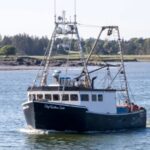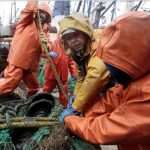Tag Archives: Army Corps of Engineers
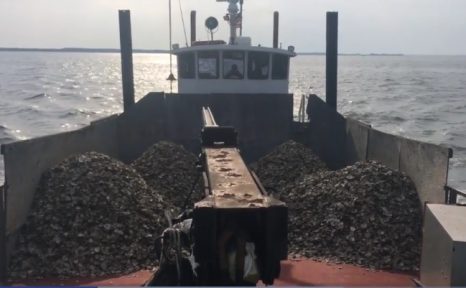
Maryland slashes oyster restoration acreage goal in Eastern Shore sanctuary
Maryland has decided to reduce the large-scale oyster restoration project goal in the Little Choptank River after boaters ran aground at another sanctuary and some of the man-made reefs there had to be rebuilt. The sanctuaries are among five planned to be built as part of a federal-state agreement to improve water quality in the Chesapeake Bay watershed.,, Skeptical of oyster restoration from the start, watermen have complained of trotlines getting stuck in new stone river bottoms and boats being damaged by oyster reef “high spots” in Harris Creek. A trotline is a long, heavy fishing line with short, baited lines suspended from it. They are often used to catch blue crabs in Maryland. click here to read the story 09:46
Sea lions hinder salmon conservation
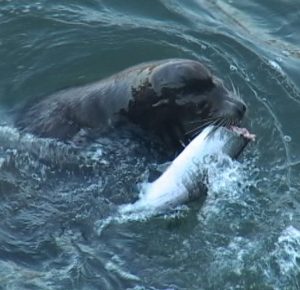 California and Steller sea lions took a bigger bite out of last year’s salmon run than in any previous year, according to a new federal report. 2015 saw a bigger run, with more than 239,000 chinook and steelhead migrating past Bonneville Dam. That year, the total number of salmon that sea lions ate was he largest ever recorded. The Army Corps of Engineers recorded more than 260 sea lions eating more than 10,000 fish from January to June 2015. The 2016 salmon run was far smaller, but the sea lions’ appetite for salmon didn’t shrink much. They still ate more than 9,500 fish, nearly 6 percent of the run. That’s the largest share of the run eaten by the large marine mammals since Army Corps scientists started watching 15 years ago. Read the rest here 12:43
California and Steller sea lions took a bigger bite out of last year’s salmon run than in any previous year, according to a new federal report. 2015 saw a bigger run, with more than 239,000 chinook and steelhead migrating past Bonneville Dam. That year, the total number of salmon that sea lions ate was he largest ever recorded. The Army Corps of Engineers recorded more than 260 sea lions eating more than 10,000 fish from January to June 2015. The 2016 salmon run was far smaller, but the sea lions’ appetite for salmon didn’t shrink much. They still ate more than 9,500 fish, nearly 6 percent of the run. That’s the largest share of the run eaten by the large marine mammals since Army Corps scientists started watching 15 years ago. Read the rest here 12:43
Apalachicola Advocates, Fishermen Continue Fight For Water
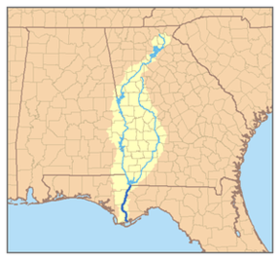 At the end of a river system that feeds booming Atlanta, and farms throughout Georgia and Alabama, sits Apalachicola Bay. The Army Corps of Engineers decides how much water flows here, where the river meets the Gulf. For years, Florida has argued it’s not getting its fair share, and the Bay and surrounding Franklin County are struggling because of it. T.J. Ward is a third generation fisherman who works at his family’s business in downtown Apalach. Over the past ten years, he’s seen the lack of freshwater take its toll, in the form of oyster predators. “One of those are, they call them snails, but we call them oyster drills, the locals do. And they eat oysters. And they’re even cannibalistic, so when they run out of oysters they’ll eat themselves. I mean they’re devastating. That’s one thing that’s killed the end of the bay that our oyster company’s on,” Ward said. Audio report, continue reading the story here 10:15
At the end of a river system that feeds booming Atlanta, and farms throughout Georgia and Alabama, sits Apalachicola Bay. The Army Corps of Engineers decides how much water flows here, where the river meets the Gulf. For years, Florida has argued it’s not getting its fair share, and the Bay and surrounding Franklin County are struggling because of it. T.J. Ward is a third generation fisherman who works at his family’s business in downtown Apalach. Over the past ten years, he’s seen the lack of freshwater take its toll, in the form of oyster predators. “One of those are, they call them snails, but we call them oyster drills, the locals do. And they eat oysters. And they’re even cannibalistic, so when they run out of oysters they’ll eat themselves. I mean they’re devastating. That’s one thing that’s killed the end of the bay that our oyster company’s on,” Ward said. Audio report, continue reading the story here 10:15
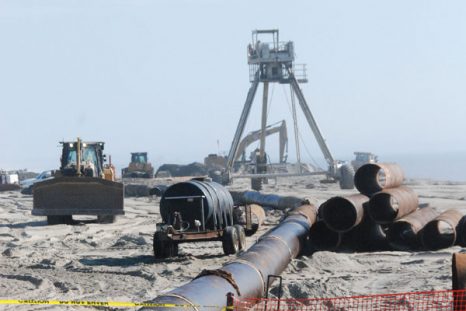
The Manasquan Ridge – Essential Fish Habitat or Common Borrow, and at what cost?
Beach replenishment is costly and exacts a heavy toll on the environment, depleting underwater ridges that are home to a broad variety of sea life. “This project is another important component of the Christie administration’s plan to bring engineered beaches and dunes to the entire coast,” state Department of Environmental Protection Commissioner Bob Martin said September 2, as he announced work would start soon on a new project, pumping another 3.8 million cubic yards of sand from the sea floor onto eight miles of beach from Atlantic City to Longport. Fishermen question the cost to the environment from demands for more and more sand on the beaches. A seafloor survey of sand ridges off Manasquan commissioned in June by the federal Bureau of Ocean Energy Management raised alarms that the Corps of Engineers could dredge more sand from undersea hills that are essential fish habitat. Collectively known as the Manasquan Ridge, the hills attract seasonal concentrations of fish, and could be a future “borrow area,” where sand is extracted to pump onto nearby beaches. “They are already planning to use borrow areas closer to the beach,” said captain James Lovgren of the Fishermen’s Dock Cooperative in Point Pleasant Beach, who, with other fishermen, met with DEP officials in late July regarding their concerns about sand mining. Read the story here 09:16
Judge Lets East Sand Island Cormorant Cull Continue
 A federal judge will allow the Army Corps of Engineers to keep shooting native cormorants by the thousands, to reduce predation on young salmon, despite objections from environmentalists who say the slaughter doesn’t address the real cause of dwindling salmon populations: hydroelectric dams. The Audubon Society of Portland led an April 2015 lawsuit against the Corps of Engineers and the U.S. Fish & Wildlife Service, claiming that the plan scapegoated a natural predator and had little effect on survival rates of young salmon. Chief among the Audubon Society’s arguments is that there are so many factors that determine whether a salmon will return from sea to spawn in its native waters that the government’s focus on cormorant predation was not only fruitless, but hurt a native bird protected by the Migratory Species Act. The government’s plan focused on East Sand Island, home to the largest breeding population of double-crested cormorants in North America. The 60-acre island is nestled in the fertile brackish waters where the Columbia River empties into the Pacific Ocean. Read the rest here 14:11
A federal judge will allow the Army Corps of Engineers to keep shooting native cormorants by the thousands, to reduce predation on young salmon, despite objections from environmentalists who say the slaughter doesn’t address the real cause of dwindling salmon populations: hydroelectric dams. The Audubon Society of Portland led an April 2015 lawsuit against the Corps of Engineers and the U.S. Fish & Wildlife Service, claiming that the plan scapegoated a natural predator and had little effect on survival rates of young salmon. Chief among the Audubon Society’s arguments is that there are so many factors that determine whether a salmon will return from sea to spawn in its native waters that the government’s focus on cormorant predation was not only fruitless, but hurt a native bird protected by the Migratory Species Act. The government’s plan focused on East Sand Island, home to the largest breeding population of double-crested cormorants in North America. The 60-acre island is nestled in the fertile brackish waters where the Columbia River empties into the Pacific Ocean. Read the rest here 14:11
N.J. fishermen fear loss of huge underwater sand hill, the Manasquan Ridge
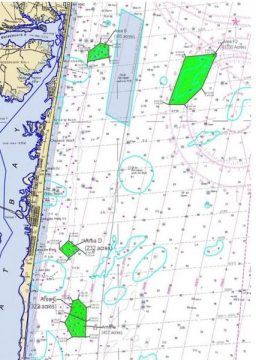 The appearance of the 123-foot offshore supply vessel Scarlett Isabella on the Manasquan Ridge is a bad omen to Capt. Jim Lovgren, a Point Pleasant Beach commercial fishermen. The Scarlett was in the hire of the Bureau of Ocean Energy Management, which is looking for potential sand on the outer continental shelf that could be pumped up onto the Jersey beach. Tampering with these sand beds, which are long-established fishing areas, could reshape the fishing communities at the Shore, fishermen say. The ridge, which starts to rise off the ocean floor 5 ½ miles southeast of Manasquan Inlet, is one of those potential resources of sand. “Last year word was that Manasquan Ridge was a last resort for beach replenishment use. The fact that they are paying a survey vessel to crisscross it clearly says something different,” said Lovgren, who sits on the Executive Board of the Garden State Seafood Association. Fishermen have been weary of a conflict with the Army Corps of Engineers over the ridge, and others nearby, which they depend on to hold fish. Read the story here 17:48
The appearance of the 123-foot offshore supply vessel Scarlett Isabella on the Manasquan Ridge is a bad omen to Capt. Jim Lovgren, a Point Pleasant Beach commercial fishermen. The Scarlett was in the hire of the Bureau of Ocean Energy Management, which is looking for potential sand on the outer continental shelf that could be pumped up onto the Jersey beach. Tampering with these sand beds, which are long-established fishing areas, could reshape the fishing communities at the Shore, fishermen say. The ridge, which starts to rise off the ocean floor 5 ½ miles southeast of Manasquan Inlet, is one of those potential resources of sand. “Last year word was that Manasquan Ridge was a last resort for beach replenishment use. The fact that they are paying a survey vessel to crisscross it clearly says something different,” said Lovgren, who sits on the Executive Board of the Garden State Seafood Association. Fishermen have been weary of a conflict with the Army Corps of Engineers over the ridge, and others nearby, which they depend on to hold fish. Read the story here 17:48
Another bump in “Ocean City Inlet” road – Commercial fishing operators say inlet’s all but closed to them as shoaling worsens
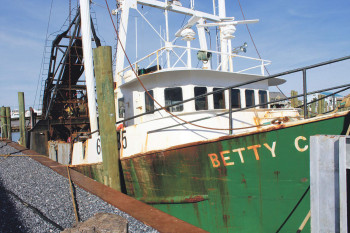 The January nor’easter, which wreaked havoc along the coast, also caused an increase in sediment into the already choking Ocean City Inlet, especially in the areas near buoys 10, 11 and 12. Two weeks ago the Capt. Frank ran aground and was stuck for six and a half hours, according to fisherman Joe Letts, and the Betty C, one of Letts’ clamming vessels, also ran aground but was able to free herself after an hour and a half. “I’m spending too much on the bottoms of my boats,” Letts said. “I don’t see why they can’t dig the S.O.B. to 20 feet and leave it alone. I’m over it. I’m in New Jersey now and am making money. Everybody’s leaving. Some of the biggest names in fishing are there and they’re tucking tail and running.” Read the rest here 09:15
The January nor’easter, which wreaked havoc along the coast, also caused an increase in sediment into the already choking Ocean City Inlet, especially in the areas near buoys 10, 11 and 12. Two weeks ago the Capt. Frank ran aground and was stuck for six and a half hours, according to fisherman Joe Letts, and the Betty C, one of Letts’ clamming vessels, also ran aground but was able to free herself after an hour and a half. “I’m spending too much on the bottoms of my boats,” Letts said. “I don’t see why they can’t dig the S.O.B. to 20 feet and leave it alone. I’m over it. I’m in New Jersey now and am making money. Everybody’s leaving. Some of the biggest names in fishing are there and they’re tucking tail and running.” Read the rest here 09:15
Fishermen pack first meeting on Mississippi DMR emergency oyster program

OC harbor dredging may see additional study
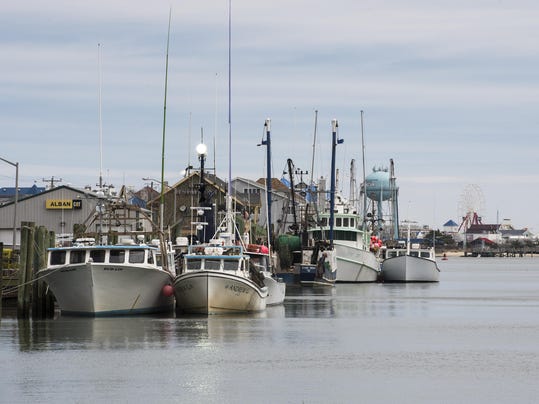 What is causing the commercial fishing harbor in West Ocean City to fill up with sand? If things go Rep. Mary Beth Carozza’s (R-38C-Wicomico-Worcester) way, there may be an answer by next year. Earlier this year, the mounting issue of the harbor’s depth came to a head and Carozza organized a stakeholder meeting to address it. Parts of the Inlet and harbor were filling up with sand every few months, watermen said, and wasn’t keeping pace. Read the rest here 09:50
What is causing the commercial fishing harbor in West Ocean City to fill up with sand? If things go Rep. Mary Beth Carozza’s (R-38C-Wicomico-Worcester) way, there may be an answer by next year. Earlier this year, the mounting issue of the harbor’s depth came to a head and Carozza organized a stakeholder meeting to address it. Parts of the Inlet and harbor were filling up with sand every few months, watermen said, and wasn’t keeping pace. Read the rest here 09:50
Army Corps withdraws Penobscot Bay dredging application – plan to dispose of contaminated spoils drew local ire
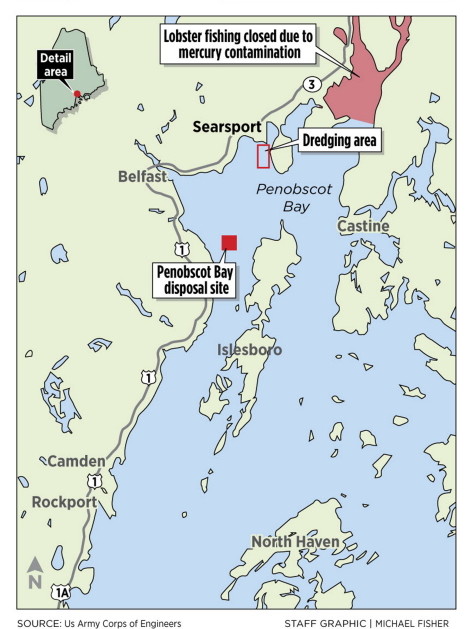 The Army Corps of Engineers withdrew on Tuesday its state permitting application for a Penobscot Bay dredging project opposed by lobstermen, tourism business owners and environmentalists. The project aims to improve and upgrade Searsport, Maine’s second-busiest port, by expanding its turning basin and deepening the approach channel from 35 to 40 feet. But the Corps’ plan for disposing of the nearly 1 million cubic yards of dredged material raised alarm bells up and down Penobscot Bay over concerns it would trigger widespread mercury contamination. Read the rest here 10:38
The Army Corps of Engineers withdrew on Tuesday its state permitting application for a Penobscot Bay dredging project opposed by lobstermen, tourism business owners and environmentalists. The project aims to improve and upgrade Searsport, Maine’s second-busiest port, by expanding its turning basin and deepening the approach channel from 35 to 40 feet. But the Corps’ plan for disposing of the nearly 1 million cubic yards of dredged material raised alarm bells up and down Penobscot Bay over concerns it would trigger widespread mercury contamination. Read the rest here 10:38
Ocean City Inlet Dredging Set For This Month, But Long-Term Commitment Still Being Sought
 While the Army Corps of Engineers will return to the resort area later this month for a short-term dredging project to temporarily fix the chronic shoaling problem in the Ocean City Inlet and commercial harbor, state and local officials continue to push for a long term solution. However, it has come to light in recent months the federally authorized 10-foot depth in the Inlet is not sufficient to sustain the multi-million dollar commercial and recreational fishing industries. “The Army Corps bases its dredging schedule on a cost-benefit ratio looking at commercial boats only,” she said. “There aren’t many left here, and when they leave, they conversely impact that cost-benefit ratio.” Read the rest here20:39
While the Army Corps of Engineers will return to the resort area later this month for a short-term dredging project to temporarily fix the chronic shoaling problem in the Ocean City Inlet and commercial harbor, state and local officials continue to push for a long term solution. However, it has come to light in recent months the federally authorized 10-foot depth in the Inlet is not sufficient to sustain the multi-million dollar commercial and recreational fishing industries. “The Army Corps bases its dredging schedule on a cost-benefit ratio looking at commercial boats only,” she said. “There aren’t many left here, and when they leave, they conversely impact that cost-benefit ratio.” Read the rest here20:39
Pledge to dredge will likely keep Oregon Inlet open in North Carolina
 Dare County commissioners agreed Thursday to dedicate $1 million to pay the Army Corps of Engineers to dredge the inlet. The move all but assures for the first time that the inlet remains open, said Dare County Commissioner Beverly Boswell. “We’ll have a dredge here when it’s needed,” she said after the vote. Oregon Inlet proponent and boat captain Harry Schiffman and others have pleaded with the county to pay for dredging for more than 20 years. Read the rest here 08:46
Dare County commissioners agreed Thursday to dedicate $1 million to pay the Army Corps of Engineers to dredge the inlet. The move all but assures for the first time that the inlet remains open, said Dare County Commissioner Beverly Boswell. “We’ll have a dredge here when it’s needed,” she said after the vote. Oregon Inlet proponent and boat captain Harry Schiffman and others have pleaded with the county to pay for dredging for more than 20 years. Read the rest here 08:46
Censored Maine Fishermen Seek Assurances that Searsport Dredging Won’t Harm Bay
 “My name is David Black and I’m from Belfast and I fish in this area out here. Wayne fishes beside me. We are the face of the destruction that this might cause out here.” Black says he worries the material will harm the bay’s fisheries. And he says state and federal regulators have not been listening to fishermen’s concerns. “I went to a hearing on the dredging for the Department of Marine Resources in Searsport about three weeks ago,” he says, “and I wanted to make comments about the disposal site out here, and I was told that my comments were not appropriate – I could not make comments on this disposal site.” Read the rest here 08:31
“My name is David Black and I’m from Belfast and I fish in this area out here. Wayne fishes beside me. We are the face of the destruction that this might cause out here.” Black says he worries the material will harm the bay’s fisheries. And he says state and federal regulators have not been listening to fishermen’s concerns. “I went to a hearing on the dredging for the Department of Marine Resources in Searsport about three weeks ago,” he says, “and I wanted to make comments about the disposal site out here, and I was told that my comments were not appropriate – I could not make comments on this disposal site.” Read the rest here 08:31
No consideration given to lobstermen by Army Corps of Engineers Royal River dredging project
 The Army Corps of Engineers is overseeing the project, which is set to begin on October 14th, and last until April. Sediment will be removed from the mouth of the Royal River and will be hauled along a 15 mile stretch to a disposal site in Portland. All fishing gear along the hauling route has to be removed by next week, and some fishermen said they did not hear about the plans until Monday morning. Video, Read the rest here 12:55
The Army Corps of Engineers is overseeing the project, which is set to begin on October 14th, and last until April. Sediment will be removed from the mouth of the Royal River and will be hauled along a 15 mile stretch to a disposal site in Portland. All fishing gear along the hauling route has to be removed by next week, and some fishermen said they did not hear about the plans until Monday morning. Video, Read the rest here 12:55
Dredge opponents fear Penobscot River pollution
 For the opponents of the Searsport dredge project, mercury contamination is the big worry. Those concerns deepened in February when the Maine Department of Marine Resources closed seven square miles to lobster and crab fishing after unsafe levels of Read more here 08:25
For the opponents of the Searsport dredge project, mercury contamination is the big worry. Those concerns deepened in February when the Maine Department of Marine Resources closed seven square miles to lobster and crab fishing after unsafe levels of Read more here 08:25
“This meeting is a sham and a shame,” ‘You are going to bury [the lobster industry]’: Skeptical crowd rips Searsport dredging project
 BELFAST, Maine — The conference room at the Hutchinson Center in Belfast was standing-room only on Tuesday afternoon as more than 200 people came to a public information meeting about a controversial Searsport Harbor dredging project. Read more here 21:23
BELFAST, Maine — The conference room at the Hutchinson Center in Belfast was standing-room only on Tuesday afternoon as more than 200 people came to a public information meeting about a controversial Searsport Harbor dredging project. Read more here 21:23
Army Corps to begin killing birds at Columbia River dam
 CLARKSTON, Wash. (AP) – The Army Corps of Engineers this spring will begin killing birds at some Snake and Columbia river dams to help protect juvenile salmon and steelhead. The corps has long used non-lethal methods to scare away birds. The plan has critics. Kierán Suckling, executive director of the Center for Biological Diversity, said there are better ways to protect the fish, such as removing the dams. Read more here 17:44
CLARKSTON, Wash. (AP) – The Army Corps of Engineers this spring will begin killing birds at some Snake and Columbia river dams to help protect juvenile salmon and steelhead. The corps has long used non-lethal methods to scare away birds. The plan has critics. Kierán Suckling, executive director of the Center for Biological Diversity, said there are better ways to protect the fish, such as removing the dams. Read more here 17:44
Port Everglades expansion plans are environmentally damaging, says National Marine Fisheries Service
The $313 million project with the Army Corps of Engineers calls for blasting and dredging through limestone and coral to deepen the port’s entrance channel from 42 feet to 48 feet. But the National Marine Fisheries Service says a draft environmental impact statement prepared by the Corps “significantly understates the project’s impacts to seagrass, coral reef and mangrove habitat” and underestimates the amount of work that would be needed to mitigate the damage. more@orlandosentinal 13:23
Environmental review of proposed Ambre Energy coal terminal should go deeper, The National Marine Fisheries Service says
![]() The National Marine Fisheries Service , which plays a consulting role in granting permits for the proposed Boardman terminal, has asked the Army Corps of Engineers bypass a speedier environmental assessment process. Instead, it wants the corps to prepare a full environmental impact statement, a more thorough process that would take years of additional study. A spokeswoman for Ambre Energy said Friday the company disagreed with the National Marine Fisheries Service’ findings. “We’re not pleased with and we don’t agree with the letter, but we’re following the corps’ process,” said Ambre spokeswoman Liz Fuller. “We think we should be going through an environmental assessment. Other projects of similar scope and size have gone through a similar environmental assessment. But we’re following directions at this point.” Read more
The National Marine Fisheries Service , which plays a consulting role in granting permits for the proposed Boardman terminal, has asked the Army Corps of Engineers bypass a speedier environmental assessment process. Instead, it wants the corps to prepare a full environmental impact statement, a more thorough process that would take years of additional study. A spokeswoman for Ambre Energy said Friday the company disagreed with the National Marine Fisheries Service’ findings. “We’re not pleased with and we don’t agree with the letter, but we’re following the corps’ process,” said Ambre spokeswoman Liz Fuller. “We think we should be going through an environmental assessment. Other projects of similar scope and size have gone through a similar environmental assessment. But we’re following directions at this point.” Read more
US Army Corps Assesses Oyster Crisis-Apalachicola- Chattahoochee-Flint water basin, Since 2005, the Corps has restricted the water flow from Lake Lanier
Eastpoint, Fla. – The last couple of months have been tough on oystermen in Franklin County, and projections look bleak. That’s why stake holders of the Apalachicola- Chattahoochee-Flint water basin invited the Army Corps of Engineers to see the devastation for themselves. The stakeholders say it basically boils down to an unbalanced system. The lack of fresh water is causing oysters to die at a rapid rate, and if you couple that with a lack of funding for research and infrastructure projects, it’s a catastrophe in the works. “There’s nothing out there to look forward to.” Devin Barber, an oysterman of 13 years says this is the worst he’s seen the bay. http://www.wmbb.com/story/19887019/us-army-corps-assesses-oyster-crisis






 Though it’s been getting progressively worse — especially after Hurricane Sandy — local officials, first gathered by Del. Mary Beth Carozza at a meeting at the Marlin Club this past spring, are working towards a solution for shoaling at the Ocean City Inlet. The Inlet serves both commercial and recreational boating interests, but it was the departure of a commercial fishing fleet helmed by Joe Letts from Ocean City waters in favor of New Jersey earlier this year, due to ease of access, that led to the issue’s prominence.
Though it’s been getting progressively worse — especially after Hurricane Sandy — local officials, first gathered by Del. Mary Beth Carozza at a meeting at the Marlin Club this past spring, are working towards a solution for shoaling at the Ocean City Inlet. The Inlet serves both commercial and recreational boating interests, but it was the departure of a commercial fishing fleet helmed by Joe Letts from Ocean City waters in favor of New Jersey earlier this year, due to ease of access, that led to the issue’s prominence. 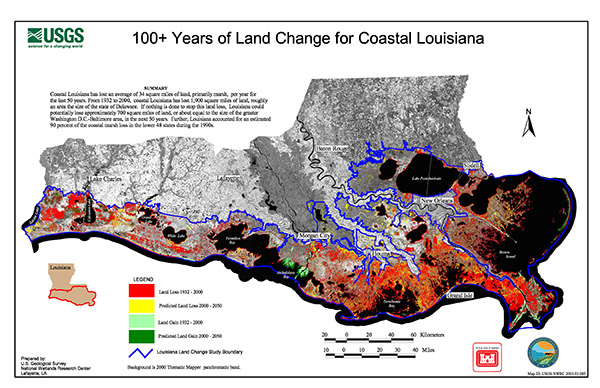 There was a time when the Mississippi carried hundreds of millions of tons of sediment a year from its sprawling drainage basin to the Gulf of Mexico. And most important here in southeast Louisiana: The river regularly overflowed, spreading nourishing silt into coastal marshes. That ended when Congress ordered the Army Corps of Engineers to wall off the river after the devastating 1927 flood. The levees strangled marshes, cutting off their sediment, and since then the state has lost 1,900 square miles of land, an area as large as Delaware
There was a time when the Mississippi carried hundreds of millions of tons of sediment a year from its sprawling drainage basin to the Gulf of Mexico. And most important here in southeast Louisiana: The river regularly overflowed, spreading nourishing silt into coastal marshes. That ended when Congress ordered the Army Corps of Engineers to wall off the river after the devastating 1927 flood. The levees strangled marshes, cutting off their sediment, and since then the state has lost 1,900 square miles of land, an area as large as Delaware 


































